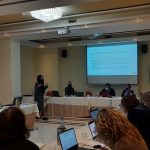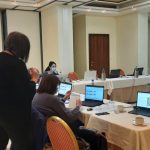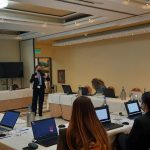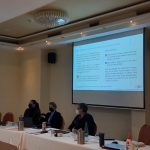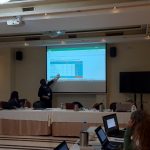News
17022022_«𝐒𝐮𝐬𝐭𝐚𝐢𝐧𝐚𝐛𝐥𝐞 𝐂𝐨𝐧𝐟𝐞𝐫𝐞𝐧𝐜𝐞𝐬 𝐚𝐧𝐝 𝐄𝐯𝐞𝐧𝐭𝐬 𝐓𝐎𝐎𝐋𝐊𝐈𝐓» workshop
NewsFeb 18th, 20220 comments
Χθες πραγματοποιήθηκε στη Λευκωσία το εργαστήρι «𝐒𝐮𝐬𝐭𝐚𝐢𝐧𝐚𝐛𝐥𝐞 𝐂𝐨𝐧𝐟𝐞𝐫𝐞𝐧𝐜𝐞𝐬 𝐚𝐧𝐝 𝐄𝐯𝐞𝐧𝐭𝐬 𝐓𝐎𝐎𝐋𝐊𝐈𝐓» στο οποίο παρουσιάστηκε το εργαλείο για το σχεδιασμό και τη διεξαγωγή αειφόρων συνεδρίων και άλλων εκδηλώσεων. Οι συμμετέχοντες είχαν την ευκαιρία να χρησιμοποιήσουν το εργαλείο και μέσα από πρακτικές άσκησες να αντιληφθούν γιατί είναι τόσο σημαντική η ένταξη αειφόρων στοιχείων στη διοργάνωση των συνεδρίων και εκδηλώσεων.
Το εργαλείο έχει αναπτυχθεί από τον Τουριστικό Οργανισμό Topkinisis Travel και την #ΑΚΤΙ και αποσκοπεί στην αναβάθμιση του συνεδριακού τουρισμού με σκοπό να καταστεί η Κύπρος ένας ελκυστικός προορισμός για την διοργάνωση διεθνών αειφόρων συνεδρίων.
Ευχαριστούμε όλες όσες συμμετείχαν, η συμβολή σας ήταν πολύτιμη!
Η δημιουργία και η προώθηση του εργαλείου συγχρηματοδοτείται από το Ευρωπαϊκό Ταμείο Περιφερειακής Ανάπτυξης και την Κυπριακή Δημοκρατία μέσω του Ιδρύματος Έρευνας και Καινοτομίας.
Ανοιχτή πρόσκληση σε σχολεία δευτεροβάθμιας εκπαίδευσης για συμμετοχή στον Διεθνή Σχολικό Διαγωνισμό «Σκέψου Έξυπνα, Δημιούργησε Πράσινα»
NewsJan 18th, 20220 comments
ENGLISH TEXT FOLLOWS
Την ευκαιρία να αναπτύξουν μοντέλα Βιώσιμων Πράσινων Κτηρίων και Έξυπνων Λιμανιών και να ευαισθητοποιηθούν σε θέματα βιώσιμης ανάπτυξης θα έχουν μαθητές/τριες σχολείων στην Κύπρο, συμμετέχοντας στον Διεθνή Σχολικό Διαγωνισμό «Σκέψου Έξυπνα, Δημιούργησε Πράσινα». Τον διαγωνισμό υλοποιεί το Ευρωπαϊκό Δίκτυο Πανεπιστημίων EU-CONEXUS ενώ στην Κύπρο τον συντονισμό έχει το Πανεπιστήμιο Frederick ως μέλος του EU-CONEXUS.
Ο διαγωνισμός απευθύνεται σε μαθητές/τριες 12-14 και 14-16 ετών και σε εκπαιδευτικούς. Οι συμμετέχοντες/ουσες καλούνται να δημιουργήσουν ομάδες και να αναπτύξουν ένα μοντέλο Βιώσιμου Πράσινου Κτηρίου ή Έξυπνου Λιμανιού για την πόλη τους, χρησιμοποιώντας βιώσιμα και βιοδιασπώμενα υλικά (για την πρώτη ηλικιακή ομάδα) ή προγράμματα όπως Minecraftschools, Roblox, Blocksworld, Growtopia, Lego Worlds, Block Craft 3D κ.λπ. (για τη δεύτερη). Πρόκειται για μια συναρπαστική εμπειρία που θα βοηθήσει τους/τις συμμετέχοντες/ουσες να αναπτύξουν χρήσιμες δεξιότητες και να ευαισθητοποιηθούν σε θέματα βιώσιμης ανάπτυξης. Οι εθνικοί νικητές του διαγωνισμού θα λάβουν διάφορα έπαθλα και θα έχουν την ευκαιρία να παρουσιάσουν τα έργα τους σε διεθνή επιτροπή, ενώ οι τρεις πρώτες ομάδες κάθε ηλικιακής κατηγορίας της διεθνούς φάσης του διαγωνισμού θα ταξιδέψουν σε μία από τις πόλεις του EU-CONEXUS ή στις Βρυξέλλες.
Η προθεσμία εκδήλωσης ενδιαφέροντος είναι η 31η Ιανουαρίου 2022 και η προθεσμία υποβολής έργου είναι η 11η Μαρτίου 2022. Για περισσότερες πληροφορίες και δήλωση συμμετοχής, ακολουθήστε τον σύνδεσμο https://www.eu-conexus.eu/en/introduction/studies/university-to-schools/. Οι ενδιαφερόμενοι/ες μπορούν επίσης να επικοινωνούν με το Πανεπιστήμιο Frederick, συντονιστή της εθνικής κριτικής επιτροπής, στα τηλ. 22394394 (Μαρία Τζούλια Αμερικάνος) και 25730975 (Βασιλική Νικολάου).
Το EU-CONEXUS αποτελεί μέρος της πρωτοβουλίας «Ευρωπαϊκά Πανεπιστήμια», μίας από τις πλέον εμβληματικές πρωτοβουλίες της Ευρωπαϊκής Ένωσης που στοχεύει στο φιλόδοξο όραμα της οικοδόμησης ενός Ευρωπαϊκού Χώρου Εκπαίδευσης και Έρευνας. Το συγκεκριμένο δίκτυο εστιάζει στην ευφυή αειφόρο παράκτια οικιστική ανάπτυξη και στόχος του είναι να αναπτύξει καινοτόμες εκπαιδευτικές μεθόδους και διεπιστημονικές προσεγγίσεις στον τομέα της «γαλάζιας ανάπτυξης», της κυκλικής οικονομίας και της αειφορίας. Στο δίκτυο συμμετέχουν ως εταίροι το Rochelle Université (Γαλλία), το Γεωπονικό Πανεπιστήμιο Αθηνών (Ελλάδα), το Technical University of Civil Engineering Bucharest (Ρουμανία), το Klaipeda University (Λιθουανία), το Universidad Catolica de Valencia “San Vicente Martir” (Ισπανία) και το University of Zadar (Κροατία) και ως συνεργαζόμενοι εταίροι το Πανεπιστήμιο Frederick (Κύπρος), το Waterford Institute of Technology (Ιρλανδία) και το University of Rostock (Γερμανία).
Secondary education students in Cyprus are given the opportunity to create a model of a Smart Green building or a Smart port for their cities and raise awareness about environmental sustainability by joining the International EU-CONEXUS School Contest “Think Smart, Create Green”. The contest is implemented by EU-CONEXUS, the European University for Smart Urban Coastal Sustainability. Frederick University, an Associated Partner of EU-CONEXUS, coordinates the national jury.
Students aged 12-14 and their teachers are invited to create a 3D model of a Smart Green building or a Smart Port by using sustainable and biodegradable materials while students aged 14-16 are invited to create a computer-designed model of a Smart Green building or Smart Port by using programmes such as Minecraftschools, Roblox, Blocksworld, Growtopia, Lego Worlds, Block Craft 3D etc. Joining the contest is promised to be a fascinating experience through which participants can develop useful skills (creativity, digital skills, team building skills and more) and raise awareness about environmental sustainability. The national winners will receive EU-CONEXUS sustainable goodies and will present virtually their projects to the international jury. The top three international teams of each category will travel to one of EU-CONEXUS cities or Brussels.
Deadline for registration is January 31st and project submission deadline is March 11th. For more information and registration follow the link: https://www.eu-conexus.eu/en/introduction/studies/university-to-schools/ You can also contact Frederick University, coordinator of the National Jury: tel. 22394394 (Maria Julia Americanos) and 25730975 (Vasiliki Nicolaou).
EU-CONEXUS is part of the European Universities initiative, a flagship programme of the European Commission created to strengthen strategic partnerships across Europe and build a European Education Area. EU-CONEXUS focuses on Smart Urban Coastal Sustainability and aims to develop innovative educational methods and cross disciplinary based approaches in the areas of Blue Growth, circular economy and sustainability.
EU-CONEXUS partner institutions are La Rochelle Université (France), Agricultural University of Athens (Greece), Klaipeda University (Lithuania), La Universidad Catolica de Valencia (Spain), University of Zadar (Croatia) and associated partner institutions are Frederick University (Cyprus), Waterford Institute of Technology (Ireland) and the University of Rostock (Germany).
Benefits of organic produce
NewsJan 12th, 20220 comments
Organic produce is food that is grown without the use of synthetic chemicals such as human-made pesticides and fertilisers and is non-GMO (genetically modified organisms). More info.
The table below indicates teh differences between orgfanic and non-organic (more info):

There are several benefits of organic produce (more info):
-Organic produce contains fewer pesticides. Chemicals such as synthetic fungicides, herbicides, and insecticides are widely used in conventional agriculture and residues remain on (and in) the food we eat.
-Organic food is often fresher because it doesn’t contain preservatives that make it last longer. Organic produce is sometimes (but not always, so watch where it is from) produced on smaller farms nearer to where it is sold.
-Organic farming tends to be better for the environment. Organic farming practices may reduce pollution, conserve water, reduce soil erosion, increase soil fertility, and use less energy. Farming without synthetic pesticides is also better for nearby birds and animals as well as people who live close to farms.
-Organically raised animals are not given antibiotics, growth hormones, or fed animal byproducts. Feeding livestock animal byproducts increases the risk of mad cow disease (BSE) and the use of antibiotics can create antibiotic-resistant strains of bacteria. Organically-raised animals tend to be given more space to move around and access to the outdoors, which help to keep them healthy.
-Organic meat and milk can be richer in certain nutrients. Results of a 2016 European study show that levels of certain nutrients, including omega-3 fatty acids, were up to 50 percent higher in organic meat and milk than in conventionally raised versions.
-Organic food is GMO-free. Genetically Modified Organisms (GMOs) or genetically engineered (GE) foods are plants whose DNA has been altered in ways that cannot occur in nature or in traditional crossbreeding, most commonly in order to be resistant to pesticides or produce an insecticide.
These facts were compiled for the purposes of the sustainable events toolkit created under the Sustainable Conferences and Events project implemented by Topkinisis Travel and AKTI Project and Research Centre. The Project ENTERPRISES/0618/0046 is co-funded by the European Regional Development Funding and the Republic of Cyprus through the Research and Innovation Foundation.
Benefits of vegan/vegetarian diets
NewsJan 12th, 20220 comments
GHG emissions
-One kilogram (kg) of beef results in 60 kg of GHG emissions—nearly 2.5 times that of the closest food type, lamb and mutton. In contrast, the same weight of apples produce less than one kilogram of GHG emissions. On average, emissions from plant-based foods are 10 to 50 times lower than animal-based types. More info

-The average annual carbon dioxide emissions from a typical meat diet are 2,055kg (5.63kg CO2e) per day, compared to 1,391kg for vegetarians (3.81kg CO2e per day) and 1,055 kg for vegans (2.89kg CO2e per day), which is less than half the amount of vegan emissions compared to meat. More info
-The livestock sector is a significant contributor to global human-induced GHG emissions. Livestock supply chains emitted an estimated total of 8.1 gigatonnes CO2-eq in 2010 (using 298 and 34 as global warming potential for N2O and CH4 respectively). Methane (CH4) accounts for about 50 percent of the total. Nitrous oxide (N2O) and carbon dioxide (CO2) represent almost equal shares with 24 and 26 percent, respectively. More info
-The below image shows global estimates of emissions by species: It includes emissions attributed to edible products and to other goods and services, such as draught power and wool. Beef cattle produce meat and non-edible outputs. Dairy cattle produce milk and meat as well as non-edible outputs. More info

-A 2021 report by Dr. Sailesh Rao found animal agriculture is responsible for at least 87% of greenhouse gas emissions. The Climate Healers position paper has been published by the Journal of Ecological Society. It argues that the influence of the meat and dairy industry has ‘underestimated’ the environmental impact of livestock farming. More info
-A 2018 Greenpeace report found that “global meat and dairy production and consumption must be cut in half by 2050 to avoid dangerous climate change and keep the Paris Agreement on track. If left unchecked, agriculture is projected to produce 52% of global greenhouse gas emissions in the coming decades, 70% of which will come from meat and dairy.” More info
-Even the most environmentally damaging plant milk type (almond) is better for the planet than dairy milk. See the image below. More info
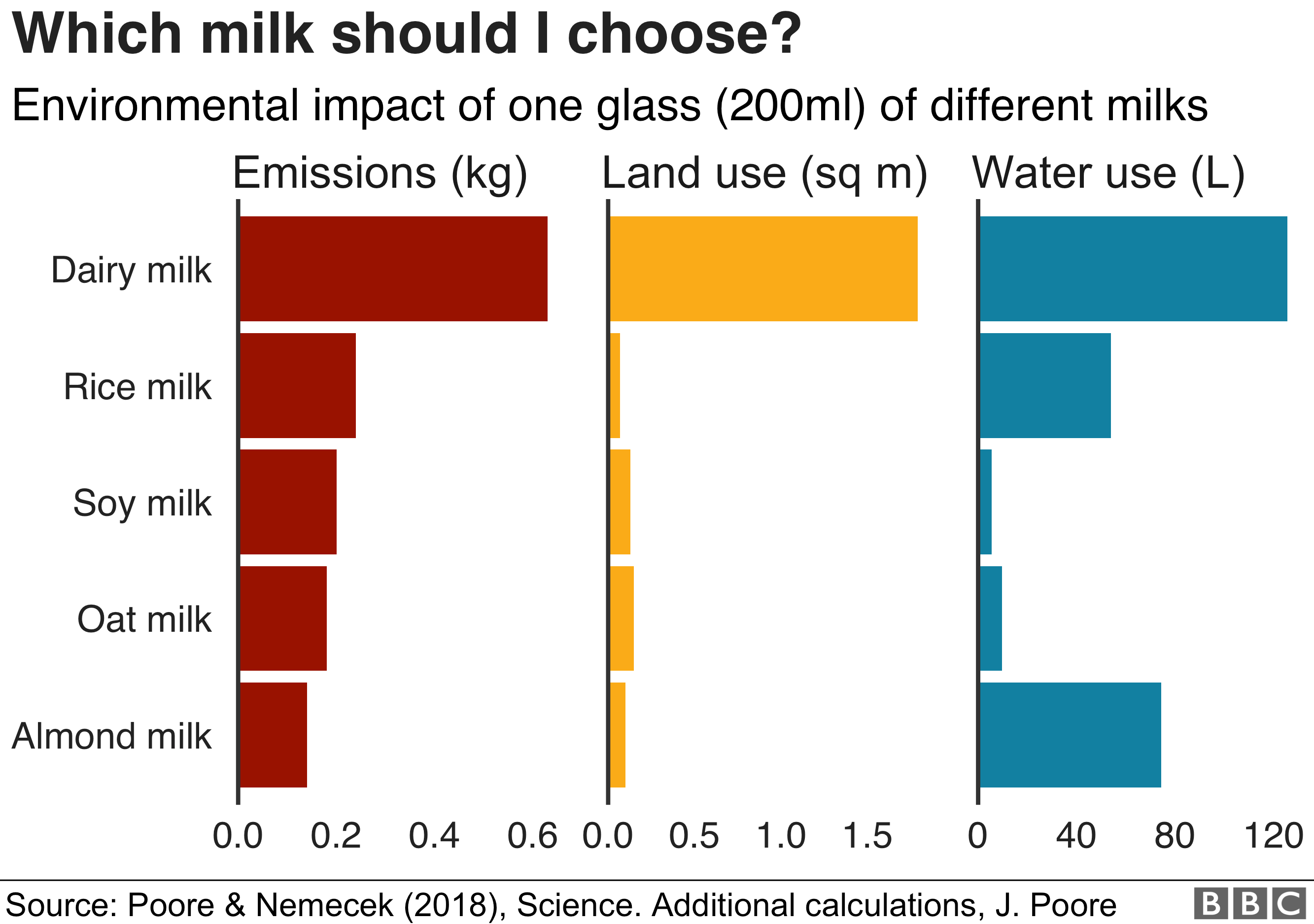
These facts were compiled for the purposes of the sustainable events toolkit created under the Sustainable Conferences and Events project implemented by Topkinisis Travel and AKTI Project and Research Centre. The Project ENTERPRISES/0618/0046 is co-funded by the European Regional Development Funding and the Republic of Cyprus through the Research and Innovation Foundation.
Water use
-Even the most environmentally damaging plant milk type (almond) is better for the planet than dairy milk. More info

-Institution of Mechanical Engineers (IME) claim that water requirements to meet food demand in 2050 could reach between 10-13.5tn cubic metres per year – about triple the current amount used annually by humans. Meat production requires a much higher amount of water than vegetables. IME state that to produce 1kg of meat requires between 5,000 and 20,000 litres of water whereas to produce 1kg of wheat requires between 500 and 4,000 litres of water. The table below shows typical values for the volume of water required to produce common foodstuffs. Beef, sheep and pork meat all require high volumes of water for production. Compared to the production of meat, vegetable foodstuffs require considerably less water. More info

These facts were compiled for the purposes of the sustainable events toolkit created under the Sustainable Conferences and Events project implemented by Topkinisis Travel and AKTI Project and Research Centre. The Project ENTERPRISES/0618/0046 is co-funded by the European Regional Development Funding and the Republic of Cyprus through the Research and Innovation Foundation.
Land use
-According to the Food and Agriculture Organization of the United Nations, deforestation is of concern because it is being carried out in order to develop farmland for livestock production and to cultivate crops for animal feed. On average about 4 million hectares of forest were felled annually in the Amazon of South America between 2001 and 2010, most of which was used as land for soybean cultivation and cattle grazing. More info
-Even the most environmentally damaging plant milk type (almond) is better for the planet than dairy milk. More info

-Animal agriculture is responsible for up to 91% of Amazon rainforest destruction. More info
-77% of the world’s farmland is used to graze farmed animals or to produce crops to feed farmed animals. More info
These facts were compiled for the purposes of the sustainable events toolkit created under the Sustainable Conferences and Events project implemented by Topkinisis Travel and AKTI Project and Research Centre. The Project ENTERPRISES/0618/0046 is co-funded by the European Regional Development Funding and the Republic of Cyprus through the Research and Innovation Foundation.
Carbon offset
NewsJan 12th, 20220 comments
There are many activities that result in carbon (or generally greenhouse gas) emissions including, but not limited to, travel, use of electricity, food waste, etc. In many cases it is almost impossible to completely reduce these emissions to zero from the source however, there is a way to make up for these emissions after they have been created. The method of doing this is known as carbon offset. Carbon offset is any activity that compensates for carbon emissions or other greenhouse gases (GHGs). More info.
There are 3 steps in the carbon offsetting process. These are numbered below (more info):
1. Calculating carbon emissions
2. Reducing emissions at the source
3. Offsetting these emissions through a specific project or scheme
In the case of step 3, carbon offset projects can include building renewable energy farms, increasing building insulation, carbon sequestration through soil and trees etc. (more info). This link provides several projects that can be invested in to offset carbon dioxide. There are also carbon offset calculators available such as this.
These facts were compiled for the purposes of the sustainable events toolkit created under the Sustainable Conferences and Events project implemented by Topkinisis Travel and AKTI Project and Research Centre. The Project ENTERPRISES/0618/0046 is co-funded by the European Regional Development Funding and the Republic of Cyprus through the Research and Innovation Foundation.
Sustainable Seafood
NewsJan 12th, 20220 comments
Environmentally sustainable seafood is wild or farmed seafood that is harvested in ways that don’t harm the environment or other wildlife — helping to ensure healthy and resilient ocean ecosystems. For wild-caught seafood that means the populations are well-managed and not overfished, and fishing gear has minimal impact on habitat and other wildlife. Aquaculture, or the farming of fish and other seafood, holds great promise as a solution to the increasing pressures on our ocean resources. When good practices are used, it’s possible to farm seafood in a way that minimizes impacts to the environment. Such operations limit habitat damage, disease, pollution, escapes of farmed fish and the use of wild fish as feed. More info
Benefits of Seasonal Eating
NewsJan 12th, 20220 comments
Seasonal Eating:
1. Supports the Local Economy: Eating with the seasons is a great way for consumers to help cultivate a more resilient, sustainable food system. When you purchase food that’s in season from local farms, you’re supporting both local farmers and the local economy.
2. Is Better for the Environment: Seasonal choices can also mean supporting food that spent less time traveling and in storage, which can significantly cut back on environmental impacts. When you purchase directly from local farmers, you can also ask them about their production methods; farmers selling at farmers’ markets or farm stands are less likely to use pesticides and more likely to use regenerative methods like cover crops that encourage soil health.
3. Is Healthier: Studies also indicate that seasonal food can be more nutritious than food consumed out of season. In fact, some research shows that fresh produce loses nutritional value over time, so berries shipped from overseas in the winter months may not be as nutrient dense as the berries purchased locally during the summer.
These facts were compiled for the purposes of the sustainable events toolkit created under the Sustainable Conferences and Events project implemented by Topkinisis Travel and AKTI Project and Research Centre. The Project ENTERPRISES/0618/0046 is co-funded by the European Regional Development Funding and the Republic of Cyprus through the Research and Innovation Foundation.
What is FSC certification?
NewsJan 12th, 20220 comments
The Forest Stewardship Council (FSC) is a forestry conservation organisation that prides themselves in protecting forests for future generations by setting standards for responsible forest management. More info.
Part of what they do is offering certification for forestry products in order to ensure that these products come from responsibly managed forests. Responsibly managed forests are named as such since they provide environmental, social and economic benefits. More info.
The FSC also provides a set of principles and critera that give a foundation for forest management standards. More info.
These facts were compiled for the purposes of the sustainable events toolkit created under the Sustainable Conferences and Events project implemented by Topkinisis Travel and AKTI Project and Research Centre. The Project ENTERPRISES/0618/0046 is co-funded by the European Regional Development Funding and the Republic of Cyprus through the Research and Innovation Foundation.
Fair Trade Certification
NewsJan 12th, 20220 comments
Fair Trade Certified seal on a product signifies that it was made according to rigorous fair trade standards that promote sustainable livelihoods and safe working conditions, protection of the environment, and strong, transparent supply chains. More info
This was put together for the purposes of the sustainable events toolkit created under the Sustainable Conferences and Events project implemented by Topkinisis Travel and AKTI Project and Research Centre. The Project ENTERPRISES/0618/0046 is co-funded by the European Regional Development Funding and the Republic of Cyprus through the Research and Innovation Foundation.
Benefits of native and endemic plant species
NewsJan 12th, 20220 comments
Native plant species are plants that are found naturally and historically within a certain region. Endemic plants are native plants with the added factor of not being found anywhere else except that particular region. Both native and endemic plants are specifically adapted to the conditions of the area they are found in whether it be extremely dry and hot or very cold and wet climates.
One of the benefits of using native and endemic plants in gardens is the fact that they can conserve water as they are adapted to these conditions. They also need less time, effort and money to tend to because of this. More info. Native and endemic plants also provide essential habitat for native wildlife, assisting in the maintenance and balance of native ecosystems. More info.
These facts were compiled for the purposes of the sustainable events toolkit created under the Sustainable Conferences and Events project implemented by Topkinisis Travel and AKTI Project and Research Centre. The Project ENTERPRISES/0618/0046 is co-funded by the European Regional Development Funding and the Republic of Cyprus through the Research and Innovation Foundation.
Archives




